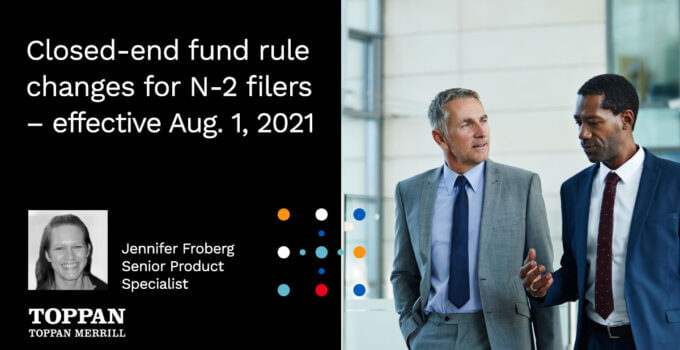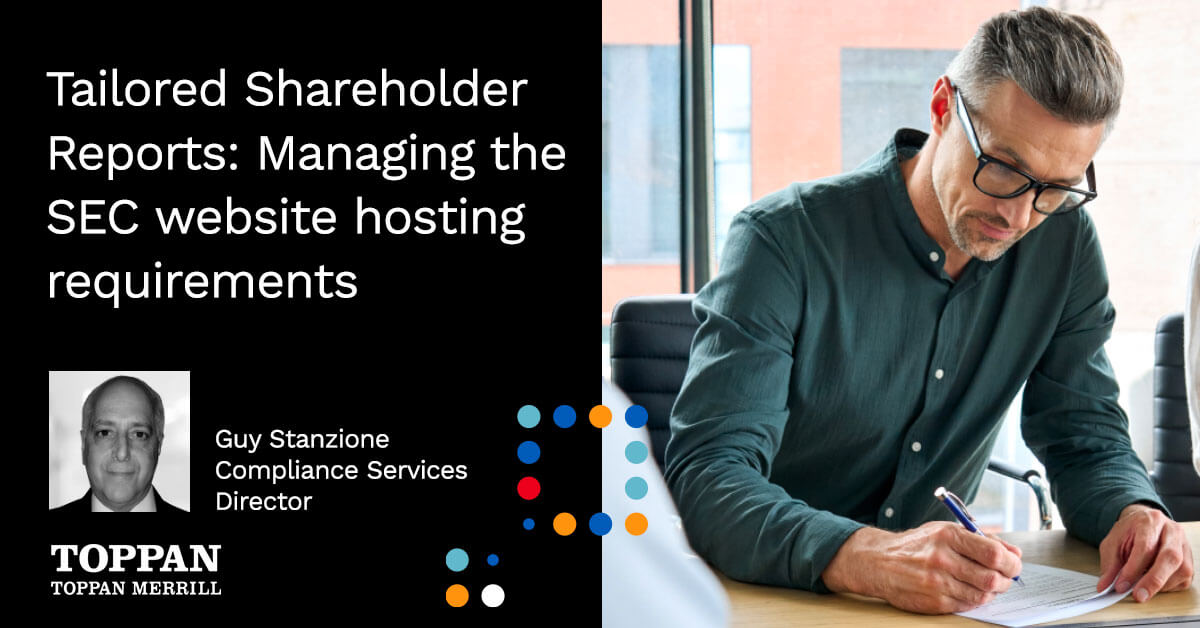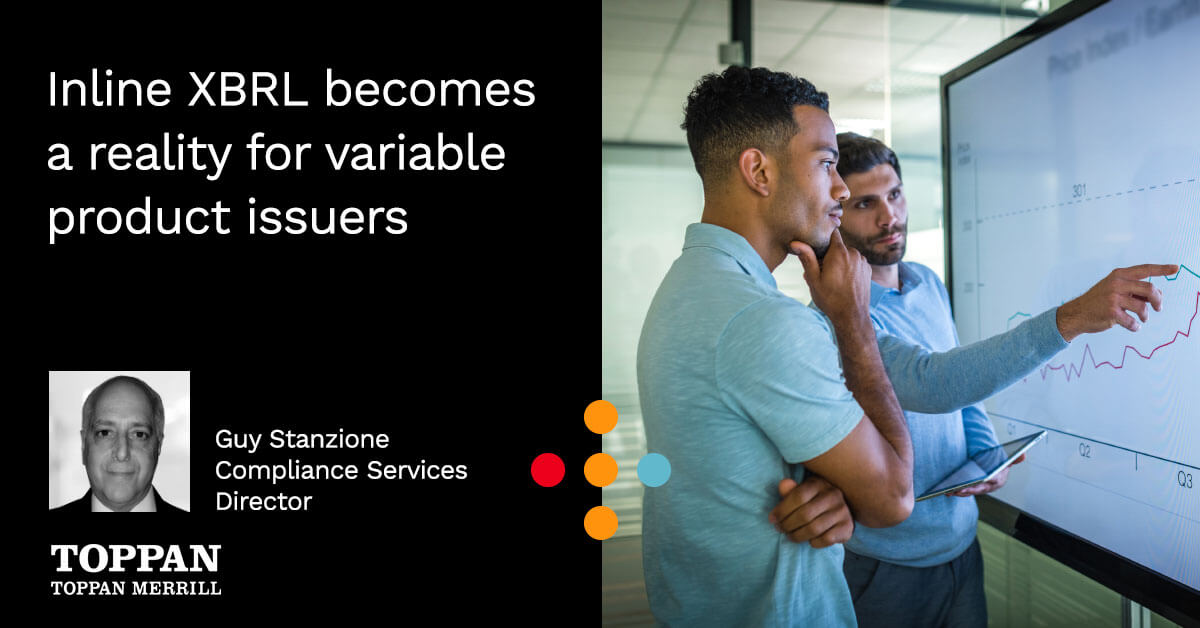How Closed-End Investment Companies are impacted, and what’s an N-2 form?
Closed-End Funds, including Business Development Companies (BDCs), register with the SEC by filing on Form N-2. The SEC adopted key Inline XBRL requirements for Closed-End Funds which will modernize their disclosure and benefit both shareholders and the Commission. The rule implements several provisions with staggered compliance dates.
Staggered compliance for Form N-2 filings
Several elements of the rule took effect initially on August 1, 2020, including:
- Funds can qualify for special status which provides benefits similar to S-3 shelf status used by corporate issuers.
- “Seasoned fund”
- Current and timely filings
- Public float of $75 million or more
- These funds can file a short form N-2 and conduct takedowns from the shelf registration statement.
- Well-Known Seasoned Issuer (“WKSI”)
- Current and timely in their filings
- Public float of $700 million or more
- WKSI funds can file an automatic shelf registration statement (N-2ASR), conduct takedowns from the shelf offering, and delay fee payments.
- Many funds are eligible to incorporate information by reference from their periodic reports into their registration statements for the first time, reducing disclosure costs and repetitive information.
The following items became effective on August 1, 2021:
- Ability to file Form 24F-2 (for Fund fees) by interval funds. Historically, Closed-End Funds were required to pay registration fees upfront, prior to their registration statement (N-2) becoming effective.
- The rule allows interval funds to reconcile their fees at the end of each fiscal year and pay registration fees on net new shares, similar to how mutual funds and Exchange Traded Funds (ETFs) have paid the SEC for years.
- This will require interval funds to file on Form 24F-2 within 90 days of the fund’s fiscal year end.
- The SEC included a provision in the final rule to account for shares that had already been registered but remained unsold at the time of the transition to filing on Form 24F-2. Those shares should be excluded from the calculation on the form.
- An initial N-2 registration statement, filed by a non-WKSI eligible fund, requires fee payment (EDGAR fee tags). The SEC modified the N-2 submission header to accommodate the new fee payment option for interval funds. EDGAR was revised to include a tag in N-2 filings ‘Is Fund 24F-2 Eligible.” When set to ‘Yes,” then no fee tags are required for the filing.
- New Fee Payment Options for Exchange Traded Products (“ETP”) that are not registered under the Investment Company Act (1940 Act). ETP issuers may now elect to register an offering of an indeterminate number of securities and to pay fees annually instead, in a manner equivalent to utilizing Form 24F-2, though technically different.
- The EDGAR system has been updated to add new fee tags on form types S-1, S-3, F-1, F-3, and related amendments. These updates are used by ETPs to report their reliance on Rules 456 and 457. Filers will select the new security type “Exchange Traded Vehicle Securities,” which then allows a choice of “Pay in Advance” or “Indeterminate.” By choosing “Indeterminate” the ETP is indicating to the SEC that they are choosing to follow the annual payment process.
- ETP issuers who elect to register an offering of an indeterminate amount of securities pursuant to rule 456(d) will be required to file a prospectus supplement (on new Form type 424I) when paying registration fees on an annual net basis. Form Type 424I [Rule 424(i)] is available on EDGAR to allow issuers to file the required prospectus supplement within 90 days after an ETP’s fiscal year end. The required disclosure for this supplement mirrors that which is required in Form 24F-2. The SEC announced that the EDGAR system will be updated on September 20, 2021, to accept 424I submissions.
- New Requirement for Closed-End Funds to include a “Management Discussion of Fund Performance” (MDFP) in their annual report. The MDFP is already reported by mutual funds and ETFs which is filed in their N-CSR. This requirement is similar to the Management Discussion and Analysis (MD&A) filed by corporate issuers in their 10-K or 20-F annual report.
- This requirement impacts any N-CSR filing submitted on or after August 1st, 2021, regardless of the fiscal year end.
Form N-2 registration filing instructions
The SEC adopted significant changes in the final rule that require Closed-End Funds to report key information in Inline XBRL format and file Form 24F-2 in XML format (implemented May 31, 2022). The form must be submitted electronically.
When preparing SEC Form N-2, there are three parts. The first is the prospectus, which should be concise, clearly written and easy to understand. This part breaks down investment fees, capital stock, debt outlook, the distribution plan, and more.
The second part, a statement of additional information (SAI), includes more details such as policies and service provider information. The third part of Form N-2 includes contract, compliance and corporate documents.
Toppan Merrill can help
Toppan Merrill is here to help with your Form N-2 registration filing and SEC compliance.
If you have questions about the 1940 Securities Act and the compliance requirements for investment companies, connect with us. You can also email [email protected] or call 800.688.4400.
Jennifer Froberg, Senior Product Specialist at Toppan Merrill
With over 15 years of industry experience in the SEC regulatory landscape, Jennifer supports and advises clients on how to get their filings right. Part of a Toppan Merrill team of EDGAR experts who provide practical compliance expertise in a variety of subjects, Jennifer focuses on analyzing the scope of SEC rulemaking and where the agency is headed.
Toppan Merrill’s deep SEC subject matter knowledge provides companies with an array of pragmatic tools to navigate the frequently changing SEC requirements. Jennifer is immersed in how regulatory changes will impact the filers, investors and the market. She has a particular focus on structured data and ESG initiatives.



